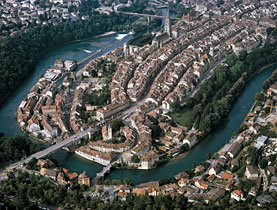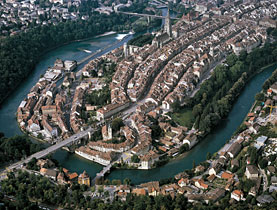The medieval pearl on the Aare

Built to a 12th century plan and constantly adapted over the years, the old city of Bern has been part of Unesco's world heritage since 1983.
It is the only Swiss Unesco site for which the UN heritage body has declared that its loss would be “irreparable for the world”.
Eager not to lose this recognition, the city authorities have developed a special conservation policy. Their aim is to find the right balance between Bern’s contemporary needs and maintaining its historical buildings.
The old centre, “should and must be used, but should never be worn out”, said Jean-Daniel Gross, the head of the city’s historical monuments service.
It is where Bern’s citizens live, work and spend leisure time. Apartments, offices, shops, restaurants, hotels, cinemas and theatres catering to the city’s globalised and multiethnic society are housed in ancient buildings, complete with cellars that can be accessed directly from the street, once used to store wine and grain.
Diversity in harmony
Bern was, from 1536-1798, the largest city-state north of the Alps. It still bears witness to its original layout – a marvel of early medieval town planning – which has been overlaid with late Baroque architecture. Into this mix come elements from other periods.
Walking along the streets, visitors can see centuries of history in the city’s monuments, towers, churches, public and private buildings. A particular highlight are the 11 inimitable fountains from the 16th century, of which ten have original Renaissance statues.
At first glance, Bern seems to be in perfect harmony. In reality, however, the facades of its long lines of grey-green buildings come in many different forms.
Bern has never displayed its wealth ostentatiously and there are treasures to be found hidden inside its buildings. The city’s old noble families decorated lavishly, with courtyards and gardens, as well as stucco and fresco, chandeliers and valuable furniture.
Protective embrace
The old city was founded in 1191 by Berthold V of Zähringer on a peninsula on a loop within the River Aare, which appears to have taken the city within its protective embrace.
The site, surrounded by a river on three sides, indeed acts as a natural fortress, which, in former times was a great advantage. This meant that only one defensive wall was needed.
Bern was built to a longitudinal plan which was adapted to its topography, with one main street in the centre and narrower side streets running parallel. Houses were built on the parcels of land in between the streets. The plan did not include squares or any tangle of alleys and lanes.
The city grew in three successive phases. But it never lost its character or its medieval layout.
Houses were originally made of wood, but after a fire in 1405 destroyed around two-thirds of them, they were rebuilt in sandstone. The arcades, so typical of Bern, also start to date from this period.
Famous fan
The city has six kilometres of arcades and they certainly made an impression on one of its most famous residents.
“I love being in Bern. An ancient, thoroughly pleasant city… There are very old arcades stretching along both sides of the streets, so you can walk from one end of the city to the other in the worst rain practically without getting wet,” wrote Albert Einstein to his future wife. Mileva Maric, in February 1902, shortly after arriving in the Swiss capital.
Einstein lived in the heart of the old town, where he worked on his groundbreaking theories. Years later, he wrote that the theory of relativity was born in Kramgasse 49 in Bern. The house has now been made into a small museum.
It forms just one of the many tourist attractions in this part of town. In addition to the cultural and religious buildings, there are the ones marking Bern’s other calling – as the main city of the canton of the same name and as the capital city of Switzerland.
Crowing rooster
Whether exploring the world heritage site on your own or taking a guided tour, there is, as one Italian visitor outside the clocktower or Zytglogge said, plenty “to fill the eyes with beauty”.
This Bernese landmark was originally built between 1218 and 1220. Every day the clocktower draws crowds to admire the 16th century clock movement, which not only drives the bellstriker, two clocks and the astronomical clock, but also moves a collection of mechanical figures, including the rooster which comes out and crows three times to announce the hour.
It’s a spectacle which appeals to both the young and the old. It also encourages them, peering up, necks cricked back, to forget about the cares of hectic modern day living – for four minutes at least.
Sonia Fenazzi in Bern, swissinfo.ch (Translated from Italian by Isobel Leybold-Johnson)
Founded in the 12th century on a hill site surrounded by the River Aare, Bern developed over the centuries in line with a an exceptionally coherent planning concept.
The buildings in the Old City, dating from a variety of periods, include 15th-century arcades and 16th-century fountains.
Most of the medieval town was restored in the 18th century but it has retained its original character.
Source: Unesco

In compliance with the JTI standards
More: SWI swissinfo.ch certified by the Journalism Trust Initiative













You can find an overview of ongoing debates with our journalists here . Please join us!
If you want to start a conversation about a topic raised in this article or want to report factual errors, email us at english@swissinfo.ch.